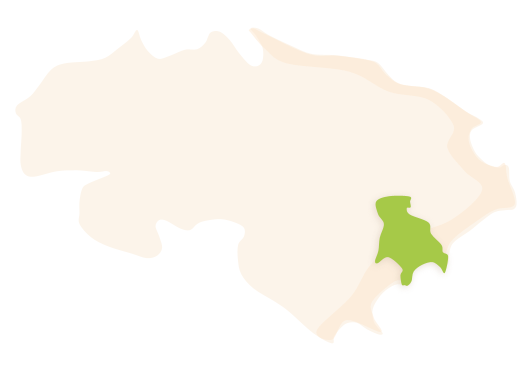Teulada and Moraira, two population centres that make up one municipality, are located on the region’s southeastern coastal strip. The municipality covers an area of 32.25 km², with altitudes that range from 185 metres above sea level in Teulada to 17 metres above sea level in Moraira. It currently has a population of 11,466, known as Teuladins and Teuladines.
 Teulada-Moraira's municipal district. Surface area: 32.25 km². Population: 11,466 (INE data 2021).
Teulada-Moraira's municipal district. Surface area: 32.25 km². Population: 11,466 (INE data 2021).HISTORY
There are traces of human activity in these lands since time immemorial. The Upper Paleolithic and Neolithic materials found in the cave known as La Cova de Les Cendres are evidence of this.
Iberian culture also made its mark until its identity was lost due to Roman arrival to the territory. After the Romans, agricultural and livestock farmers who possibly gave the municipality its name, came the Arabs, who shaped the characteristically terraced landscape that we enjoy today. To them we also owe many of the place names of the municipality’s different parts. During the Muslim era, Teulada was a farmstead that formed part of the territory of the castle of Calp, which also included Benissa. At that time the settlement would have been dispersed throughout the area, as is documented in Marsa Mudayra (Portitxol de Moraira).
The first written appearance of the village is in Jaume I’s Llibre de Repartiment, or Distribution Book of 1245. Between 1270 and 1280 these regions were repopulated by Catalan families who brought with them their languages. In 1377 the area obtained its administrative independence and in 1386 the municipality was legally formed. Along with Calp, Pego and Xàbia, Teulada became one of the region’s exclusively Christian towns.
The town’s connection with Saint Vicent Ferrer is also famous. He visited it in 1410 because, amongst other reasons, his sister, Constança Ferrer, was married and living in Teulada.
The 15th, 16th and 17th centuries were framed by the continuous attacks of Barbary pirates. These incidents led to a large process of fortification undertaken on the Valencian coast in the areas of highest conflict. The tower known as La Torre del Cap d’Or de Moraira dates from that period along with other of Teulada’s outstanding heritage works such as the church, L’Església-Fortalesa de Santa Catalina, and the courtroom, La Sala de Jurats i Justícies.
After the 1744 construction of the tower known as Castell de Moraira or Castell de La Mar, and under its subsequent protection, a small population centre began to develop. The primary, but not only, activity of this populace would be fishing.
With the arrival of the raisin economy at the end of the 18th century, dry stone terraces almost entirely filled the fertile valley between the two population centres, and the riuraus, constructions necessary for drying raisins in optimum conditions, began to appear.
FESTIVITIES
- The patron saint festivities of Moraira are held in honour of La Mare dels Desemparats (Our Lady of the Forsaken) and La Mare de Déu del Carme (Virgin of Carmel) on the 15th and 16th of July.
- Teulada’s patron saint festivities in honour of Saint Vicent Ferrer are celebrated the week after Easter. The main day, the day of Saint Vicente Ferrer, is the Monday following Easter Monday.
- Moraira’s festivities of Moors and Christians are held in the second or third week of June.
- La Nit de Sant Joan (Saint John’s Night).
- Bonfires and demons of Saint Antoni.
GASTRONOMY
- “Arròs a banda” (rice dish of fish and seafood, prepared in the style of paella).
- Sardine and spinach paella.
- ”Bull” (preserved tuna offal).
- ”Dames” (sweet pastries traditionally eaten on the day of Saint Blai).
- Wine